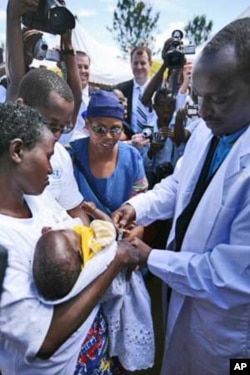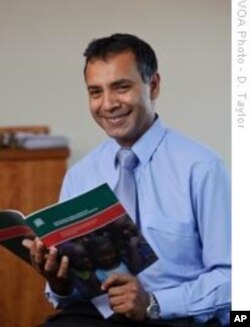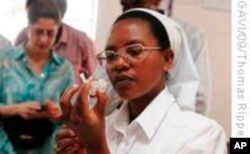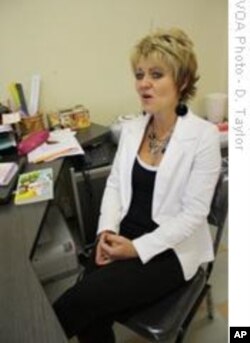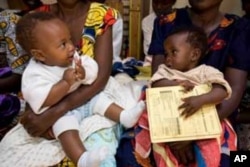A swirling gale raises red dust in the crumbling streets of Dithlake, an impoverished township in the west of South Africa’s central Free State province. The same warm wind flattens nearby wheat fields, almost iridescently golden, and seemingly endless pastures of bright yellow sunflowers.
But Dithlake is far from a rural idyll.
Many of the area’s children get pneumonia. Some die, their bodies buried under simple slabs of concrete in the local graveyard. Public health facilities in the district are scarce.
Three-year-old Daniel Petrus lives with his parents in a small shack in Dithlake. The two-roomed building is made out of corrugated iron and soggy wooden panels. Daniel’s father has placed old tires on top of the rusty roof to prevent it from blowing off.
The Petrus family is poor. Daniel’s only toy is a bald, graying tennis ball, which he rolls across a dirty makeshift floor of loose bricks. But the child appears happy, laughing as his sticky fingers once again collect his ball.
Yet just a month ago, his mother says, Daniel was almost dead. “He couldn’t breathe,” she whispers.
Fortunately, a relative was able to rush Daniel to hospital in the nearest large city, Bloemfontein. He was diagnosed with pneumonia, but he survived after treatment.
Prof. Shabir Madhi, a top South African pediatrician, says Daniel’s a “very lucky” boy. He could easily have become one of the estimated 300,000 African youngsters killed by pneumococcal disease every year.
Youngsters on the continent die in particularly tragic circumstances, since these illnesses are completely preventable. Due to medical advances, deaths from pneumococcal disease have become rare in the developed world, but are still common across Africa.
Leading cause of death
“Pneumococcal disease is probably the leading cause of death in children from any single pathogen,” says Madhi, the co-director of the University of the Witwatersrand’s respiratory and meningeal pathogens research unit.
The illnesses are so common, he says, because pneumococcus bacteria are present in six out of every ten people’s mouths. But while most healthy adults are strong enough to resist adverse effects, babies and very young children – and HIV-infected people with weak immune systems - aren’t.
“It’s a bacteria which can cause serious ear infections (sometimes leading to deafness), and infections of the chest or the lungs – which we call pneumonia – as well as infections around the brain, which is known as meningitis,” Madhi explains.
He says when a child first falls ill with pneumonia it often seems as if it just has a mild cold, with a runny nose and a fever. “But quite a few of those children eventually end up developing a superimposed pneumococcal infection. And when they develop this, over and above the underlying viral infection, that’s when they become really ill,” Madhi says.
The infected child has a bad cough, battles to breathe, and grunts. Eventually, the lips of a baby that’s severely affected will turn blue, because it can’t get enough oxygen.
“The problem with pneumococcal pneumonia is that if there’s not good access to health care, it’s a disease which can be extremely fatal,” Madhi tells VOA. “In rural areas in South Africa or in other settings in Africa….children that can’t get to health care facilities (soon after) they develop pneumonia, there’s a very high mortality rate.”
The scientist also specializes in meningitis. Again, in the case of this illness, an infected child will experience a fever, but also accompanied by a headache, blurred vision, vomiting, and neck stiffness. Even with access to good care, says Madhi, three out of every ten people who get pneumococcal meningitis, die.
Over the past two decades, the professor explains, it’s become especially difficult to treat pneumococcal disease in South Africa, as the pneumococcus bacteria has developed resistance to antibiotics that were once successful in fighting it.
This “major obstacle,” says Madhi, spurred him on to do intensive research to prevent the disease from occurring, rather than relying on antibiotics to actually treat it. International health experts consider the work completed by the South African professor and his team in this regard as groundbreaking.
The Soweto trials and the HIV link
Madhi’s unit is at the Chris Hani – Baragwanath Hospital, the largest hospital in the southern hemisphere, in Soweto on the outskirts of South Africa’s biggest city, Johannesburg. About two million people reside in the area where poverty is rife. Every day, more than 2,000 patients check into the facility…. with almost a quarter of them being HIV-positive.
About 22, 000 of the 30,000 children born annually in Soweto are delivered at the hospital locals call ‘Bara,’ which has made it an ideal setting for Madhi’s life-saving mission.
Over the past few years, the researcher has evaluated the efficacy of medicine designed to prevent pneumonia and meningitis. Madhi has given the pneumococcal conjugate vaccine (PCV) - which included the ingredients of the commercially available drug, Prevenar - to 40,000 babies, of whom 2,500 were HIV-positive.
In South Africa - at 5.5 million, the country with the highest number of HIV-infected people in the world – Madhi says it’s “impossible” to separate pneumococcal disease from HIV. “Largely because of the HIV pandemic, there’s a huge child and infant mortality rate in Soweto. But the real reasons why these children die are complications because of HIV and AIDS. And one of the major complications of HIV and AIDS is in fact death due to pneumonia,” he explains.
Because their immune systems are so weak, HIV-infected children are particularly susceptible to pneumococcal illnesses, with three-quarters of all cases in South Africa occurring in youngsters with HIV.
Madhi’s work in Soweto has yielded tremendously positive results.
“By vaccinating children we were able to reduce severe invasive pneumococcal disease due to those strains included in the vaccine by 85 percent in HIV-uninfected kids, and by 65 percent in HIV-infected kids,” the professor enthuses.
In April 2009, largely as a result of Madhi’s team’s efforts, the South African government became the first in Africa to introduce the pneumococcal vaccine – trade-name, Prevenar - into the country’s public immunization program.
The scientist says South African babies are now receiving the inoculation in three doses, injected at six and 14 weeks of age, and finally when the child is nine months old.
Vaccine is ‘invisible’ in some poor areas
Even South Africa’s notoriously anti-government health activists have praised the state for budgeting millions of dollars to save children’s lives. But challenges remain. In isolated, under-resourced areas of the country – such as Dithlake - Prevenar is invisible.
“I must say, working in the rural communities of the Free State….the communities that really need this vaccine are ignorant about its existence,” says Dr. Petro Basson, a highly-qualified nurse who regularly visits health facilities to care for children with “life-limiting” conditions, including HIV.
Madhi, who’s also a member of a government task team on immunization, acknowledges that there were initially “some hurdles” in terms of introducing the vaccine throughout South Africa. But he says these have largely been overcome and that “full national coverage” will soon be achieved.
Basson maintains, though, that it’s “hard” for people in particularly the nation’s isolated rural areas to immunize their children, especially in light of the fact that three separate injections at different stages of a baby’s early life have to be administered for the vaccine to be effective.
“They stay 20 kilometers from the nearest clinic. So this makes it very, very difficult. It’s hard for them to visit a clinic even once. There isn’t an ambulance that can pick the child up because it isn’t an emergency situation (to get a booster injection),” the nurse laments.
The only solution, Basson insists, is for the South African government to build more clinics. But some health economists say the authorities are already short of cash, with the state’s pneumococcal immunization program costing at least 600 million rand (US $ 85 million) a year.
Extreme expense of Prevenar
However, South Africa is fortunate. Without donor funding, the vaccine remains out of reach for most African countries.
“It’s extremely expensive,” says Madhi. In the private sector in South Africa, the cost of one dose of Prevenar is almost US$ 200, with each child needing three doses.
Madhi adds ruefully, “That’s basically more than the income of families in many African countries, for an entire year or even two.”
But the Global Alliance for Vaccines and Immunization – or GAVI – is coming to the rescue of some of the extremely resource-poor countries that are in dire need of Prevenar. GAVI has provided support to Rwanda, for example, to introduce pneumococcal vaccine into its national immunization program. GAVI is partly funded by a number of industrialized countries, and South Africa itself contributes to the initiative, as does the Bill Gates Foundation.
South Africa, explains Madhi, doesn’t qualify for GAVI assistance, since its per capita income is more than $1,000 a year – hence its state support for pneumococcal immunization.
GAVI aims to introduce Prevenar into at least 45 eligible countries within the next five years.
“That’s a very ambitious program. And if that does happen, it would save close on four to five hundred thousand children dying each year,” Madhi states. But he adds that it’ll be a “major challenge for these countries to sustain these immunization programs when the donor money dries up.”
At the moment though, Madhi is choosing to reflect on the positive aspects of South Africa’s initiative. “By preventing children from dying today, what we’re basically investing in is allowing those children to actually develop their potential and hopefully to be productive members of society into the future,” he says.
This is part 15 of our 15 part series, A Healthy Start: On the Frontlines of Maternal and Infant Care in Africa





